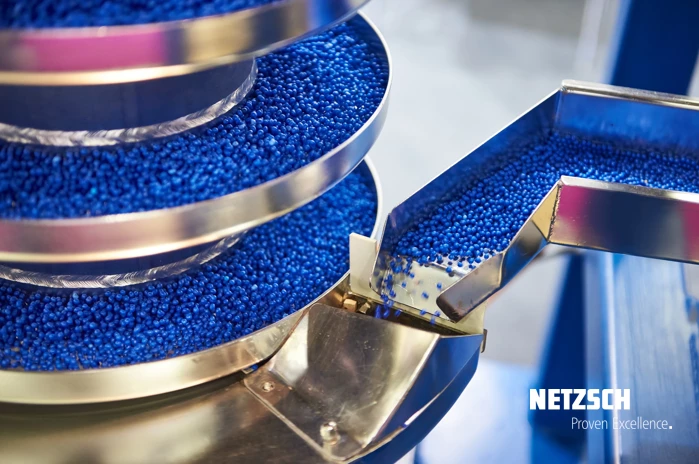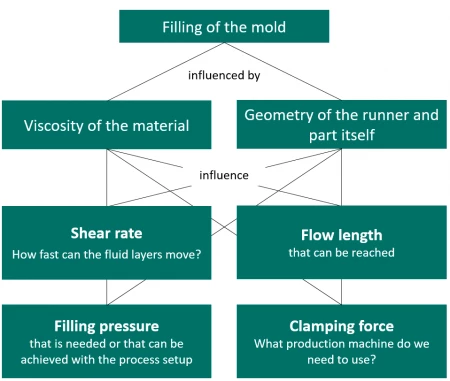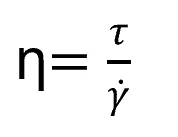
22.06.2023 by Milena Riedl
The Basics of Capillary Rheometry
Rheology studies the deformation and flow of fluids. Traditionally, capillary rheometers have been used to measure the shear viscosity and elasticity of viscous materials at high shear rates. Learn why you need a capillary rheometer and what data you can obtain.
“Rheology studies the deformation and flow of fluids. […] Traditionally, capillary rheometers have been used to measure the shear viscosity and elasticity of viscous materials at high shear rates. […] The interest in high shear rates stems from the mode of deformation a material will undergo in processes like extrusion, film blowing, and injection molding.” [1]
The responses of a material to deformation or just the environment itself happen on different time scales. Some processes take years such as physical aging and CreepCreep은 일정한 힘 아래에서 시간과 온도에 따라 달라지는 소성 변형을 나타냅니다. 고무 화합물에 일정한 힘이 가해지면 가해진 힘에 인해 발생하는 초기 변형이 고정되지 않습니다. 변형은 시간이 지남에 따라 증가합니다creep. Other processes happen in seconds or milliseconds, e.g., impact behavior or shearing and elongation during processing like extrusion, blow molding and injection molding.
The faster the material’s response, the faster the rate of deformation needs to be. This is also why rotational rheometers are not suitable for these processes. Their functional principle is designed to detect changes on the molecular level up to low or medium deformation. However, capillary rheometers cover the other side of the spectrum – processes that happen on a fast time scale.

Why do you need capillary rheometry?
In an injection molding process, for example, the viscosity of the material and the geometry of the runner and part itself influences the filling of the mold. In turn, these two parameter influence the shear rates, filling pressure, flow length and even the clamping force that is needed to keep the mold closed.
What data can be obtained by means of a capillary rheometer?
- Melt viscosity
Viscosity can be thought of as the fluidity of a liquid, or how much it resists flow. Viscosity, η, is expressed as the ratio of shear StressStress is defined as a level of force applied on a sample with a well-defined cross section. (Stress = force/area). Samples having a circular or rectangular cross section can be compressed or stretched. Elastic materials like rubber can be stretched up to 5 to 10 times their original length.stress (force per unit area) to the shear rate (rate change of shear StrainStrain describes a deformation of a material, which is loaded mechanically by an external force or stress. Rubber compounds show creep properties, if a static load is applied.strain). [2]

- High shear rate behavior
The shear rate is the rate at which a fluid is sheared or deformed during flow. In more technical terms, it is the rate at which fluid layers move past each other. If someone quickly rubs a very thin layer of ointment, cream, or lotion on the skin, for example, then the shear rate is much higher than if that material is slowly squeezed out of its tube. [3]
- Extensional properties
Extensional flow occurs when the material is not in contact with solid boundaries, as is the case during drawing of filaments, fibers, films, sheets or inflating bubbles. Converging flows at the inlets of dies are also extensional in nature. [4] Extensional properties include extensional-StrainStrain describes a deformation of a material, which is loaded mechanically by an external force or stress. Rubber compounds show creep properties, if a static load is applied.strain rate and extensional viscosity.
- Melt fracture (Flow Instability)
Melt fracture is defined as the phenomenon caused by excessive shear StressStress is defined as a level of force applied on a sample with a well-defined cross section. (Stress = force/area). Samples having a circular or rectangular cross section can be compressed or stretched. Elastic materials like rubber can be stretched up to 5 to 10 times their original length.stress exerted on the molten resin that leads to roughness in the extrudate. [5] It is an undesired surface effect that can also affect the part properties. Since it occurs at high shear stresses for the material under investigation, it can be reduced or eliminated by reducing the throughput.
- StressStress is defined as a level of force applied on a sample with a well-defined cross section. (Stress = force/area). Samples having a circular or rectangular cross section can be compressed or stretched. Elastic materials like rubber can be stretched up to 5 to 10 times their original length.Stress RelaxationRelaxation은 고무에 일정한 변형률이 가해지면, 변형률을 유지하기 위해 필요한 힘은 일정하지는 않지만 시간에 따라 감소합니다. 이러한 특성을 ‘응력 완화’라고 부릅니다. 응력완화의 원인이 되는 과정은 물리적 또는 화학적 그리고 정상적인 조건 하에, 둘 다 동시에 일어날 수 있습니다. Relaxation (Relative)
StressStress is defined as a level of force applied on a sample with a well-defined cross section. (Stress = force/area). Samples having a circular or rectangular cross section can be compressed or stretched. Elastic materials like rubber can be stretched up to 5 to 10 times their original length.Stress RelaxationRelaxation은 고무에 일정한 변형률이 가해지면, 변형률을 유지하기 위해 필요한 힘은 일정하지는 않지만 시간에 따라 감소합니다. 이러한 특성을 ‘응력 완화’라고 부릅니다. 응력완화의 원인이 되는 과정은 물리적 또는 화학적 그리고 정상적인 조건 하에, 둘 다 동시에 일어날 수 있습니다. relaxation is a time-dependent decrease in StressStress is defined as a level of force applied on a sample with a well-defined cross section. (Stress = force/area). Samples having a circular or rectangular cross section can be compressed or stretched. Elastic materials like rubber can be stretched up to 5 to 10 times their original length.stress under a constant StrainStrain describes a deformation of a material, which is loaded mechanically by an external force or stress. Rubber compounds show creep properties, if a static load is applied.strain. This characteristic behavior of the polymer is studied by applying a fixed amount of deformation to a specimen and measuring the load required to maintain it as a function of time. [6]
- Melt strength
Melt strength can be described as the resistance of the polymer melt to stretching. The melt strength of a material is related to the molecular chain entanglements of the polymer and its resistance to untangling under StrainStrain describes a deformation of a material, which is loaded mechanically by an external force or stress. Rubber compounds show creep properties, if a static load is applied.strain. The polymer properties affecting the resistance to untangling are molecular weight, molecular-weight distribution (MWD) and molecular branching. As each property increases, the melt strength is improved at low shear rates. [7] It is an important property for successful extrusion of plastic materials.
- Die swell
Die swell occurs when a material flows out of the capillary die. One way to explain die swell is to consider the ability of the polymer melt to remember its flow history. The idea is to imagine a fluid element moving from the reservoir into a capillary die as a short, fat cylinder being squeezed into a long, slender cylinder. If the residence time of the fluid element in the die is shorter than the time of its fading memory (RelaxationRelaxation은 고무에 일정한 변형률이 가해지면, 변형률을 유지하기 위해 필요한 힘은 일정하지는 않지만 시간에 따라 감소합니다. 이러한 특성을 ‘응력 완화’라고 부릅니다. 응력완화의 원인이 되는 과정은 물리적 또는 화학적 그리고 정상적인 조건 하에, 둘 다 동시에 일어날 수 있습니다. relaxation time), it will try to return to its original shape and produce the die swell effect. [8]
- pvT behavior and compressibility
pvT investigates the relationship between pressure and volume in a material. It further gives an indication of how compressible a polymer melt is. As polymers are processed at high temperatures and pressures, the relationship between pressure, volume and temperature is of great importance.
For what do you need the data from a capillary rheometer?
Other reasons why we need capillary rheometer data: Measure the flow behavior of a material for quality control and assurance, do processing studies (shear dependency), or obtain input model parameters for flow simulations. We can study formulations to assess the effect of fillers, processing aides and production enhancers.
Next week, we will cover the working principle of a capillary rheometer, explain the characteristic viscosity flow curve and highlight the importance of necessary corrections.
Sources:
[1] Dao, T.T., Ye, A.X., Shaito, A.A., Roye, N., Hedman, K. (2009): Capillary Rheometry: Analysis of Low-Viscosity Fluids, and Viscous Liquids and Melts at High Shear Rates; retrieved from: https://www.americanlaboratory.com/913-Technical-Articles/557-Capillary-Rheometry-Analysis-of-Low-Viscosity-Fluids-and-Viscous-Liquids-and-Melts-at-High-Shear-Rates/
[2] https://www.dc.engr.scu.edu/cmdoc/dg_doc/develop/process/physics/b3200002.htm
[3] Moonay, D. (2017): What is Shear Rate and Why is it Important?; retrieved from: https://www.labcompare.com/10-Featured-Articles/338534-What-is-Shear-Rate-and-Why-is-it-Important/
[4] Shenoy, A.V. (1999): Rheology of Filled Polymer Systems; retrieved from: https://link.springer.com/chapter/10.1007/978-94-015-9213-0_9
[5] Ebnesajjad, S. (2017): Fluoroplastics; retrieved from: https://www.sciencedirect.com/topics/engineering/melt-fracture
[6] Ashter, S.A. (2014): Thermoforming of Single and Multilayer Laminates; retrieved from: https://www.sciencedirect.com/topics/engineering/stress-relaxation
[7] Frankland, J. (2013): Extrusion: Where’s the Data? The Importance of Melt Strength in Extrusion; retrieved from: https://www.ptonline.com/articles/what-about-melt-strength
[8] Koopmans, R.J. (1999): Polypropylene; retrieved from: https://link.springer.com/chapter/10.1007/978-94-011-4421-6_22